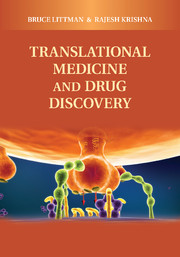Book contents
- Frontmatter
- Contents
- Contributors
- Preface
- Translational Medicine and Drug Discovery
- SECTION I TRANSLATIONAL MEDICINE: HISTORY, PRINCIPLES, AND APPLICATION IN DRUG DEVELOPMENT
- 1 TRANSLATIONAL MEDICINE: DEFINITION, HISTORY, AND STRATEGIES
- 2 TRANSLATIONAL MEDICINE AND ITS IMPACT ON DIABETES DRUG DEVELOPMENT
- 3 CHALLENGES IN ATHEROSCLEROSIS
- 4 OBESITY: NEW MECHANISMS AND TRANSLATIONAL PARADIGMS
- 5 BONE DISORDERS: TRANSLATIONAL MEDICINE CASE STUDIES
- 6 CASE STUDIES IN NEUROSCIENCE: UNIQUE CHALLENGES AND EXAMPLES
- 7 TRANSLATIONAL MEDICINE IN ONCOLOGY
- SECTION II BIOMARKERS AND PUBLIC–PRIVATE PARTNERSHIPS
- SECTION III FUTURE DIRECTIONS
- Index
- References
2 - TRANSLATIONAL MEDICINE AND ITS IMPACT ON DIABETES DRUG DEVELOPMENT
Published online by Cambridge University Press: 04 April 2011
- Frontmatter
- Contents
- Contributors
- Preface
- Translational Medicine and Drug Discovery
- SECTION I TRANSLATIONAL MEDICINE: HISTORY, PRINCIPLES, AND APPLICATION IN DRUG DEVELOPMENT
- 1 TRANSLATIONAL MEDICINE: DEFINITION, HISTORY, AND STRATEGIES
- 2 TRANSLATIONAL MEDICINE AND ITS IMPACT ON DIABETES DRUG DEVELOPMENT
- 3 CHALLENGES IN ATHEROSCLEROSIS
- 4 OBESITY: NEW MECHANISMS AND TRANSLATIONAL PARADIGMS
- 5 BONE DISORDERS: TRANSLATIONAL MEDICINE CASE STUDIES
- 6 CASE STUDIES IN NEUROSCIENCE: UNIQUE CHALLENGES AND EXAMPLES
- 7 TRANSLATIONAL MEDICINE IN ONCOLOGY
- SECTION II BIOMARKERS AND PUBLIC–PRIVATE PARTNERSHIPS
- SECTION III FUTURE DIRECTIONS
- Index
- References
Summary
Introduction
Type 2 diabetes is one of the largest medical burdens in the United States. At present it is estimated that 23.6 million people in the United States have diabetes (7.8% of the population) of which 5.7 million remain undiagnosed. Of this total, approximately 95% have type 2 diabetes. In addition to insulin, eight different drug classes are available for the treatment of type 2 diabetes. In spite of all these drugs being available, many of them generic, only 49.8% of patients reach the American Diabetes Association–recommended targets for glucose control. Moreover, many patients require the addition of a second therapy to maintain glucose control. Thirty-six percent require a second therapy with a mean time to failure from start of initial therapy of 1.51 years. Thus, many patients require multiple medications and often eventual insulin replacement. Furthermore, many of the existing drugs have characteristics and potential adverse effects that make them less than ideal.
Macrovascular and microvascular complications continue to take a heavy toll on patients with diabetes. An estimated 57.9% of people with type 2 diabetes have one or more complications. As a nation, the United States spends $57.1 billion a year in health care related to diabetes and its complications. With an estimated 57 million people now having prediabetes, this metabolic pandemic can only be expected to grow unless serious steps are taken at the public health and drug development levels. Therefore, the need for better drugs for type 2 diabetes is now stronger than ever.
- Type
- Chapter
- Information
- Translational Medicine and Drug Discovery , pp. 35 - 61Publisher: Cambridge University PressPrint publication year: 2011



